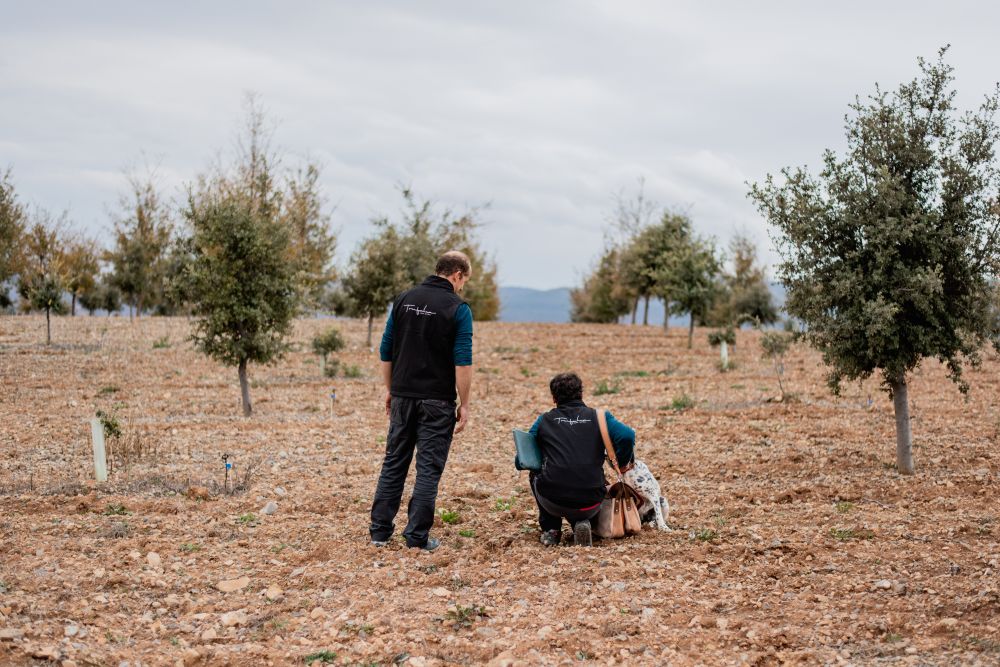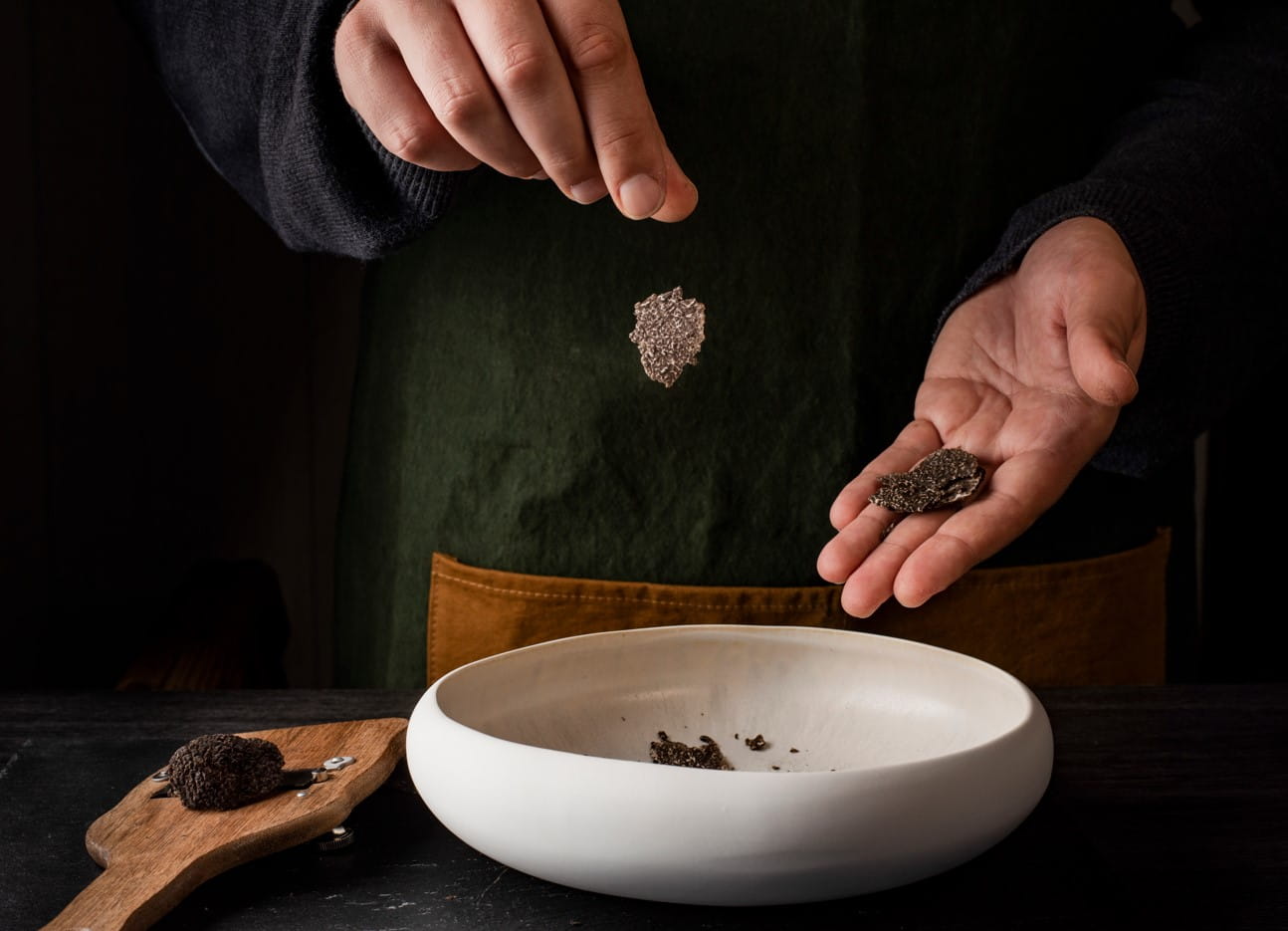The black truffle (Tuber melanosporum Vitt.) is one of the most valued gourmet products in the world today. This fungus grows underground, in symbiosis with the roots of certain species of trees such as holm oaks, oaks and hazelnut trees, in specific geographical areas with very specific climatic conditions. Its natural cycle is as peculiar as it is fascinating, since harvesting begins in mid-November and lasts until the end of March or the beginning of April.
It is not only a long process, but also a laborious one. Black truffles have to be located when they are at their peak of ripeness, which requires the involvement of trained truffle dogs to identify their unique aroma underground. No wonder, then, that the black truffle commands such a high price on the international market. Its high price is due to a combination of factors: its rarity, the complexity of its harvesting and, above all, its unmistakable flavour and aroma, which are capable of transforming the simplest dishes into authentic delicacies worthy of the world of haute cuisine.
What is truffle farming?
Truffle farming is a specialised agricultural technique that allows the cultivation of black truffles (Tuber melanosporum Vitt.) by planting mycorrhizal trees. That is, trees whose roots have been inoculated with the truffle fungus, allowing this natural symbiosis to develop over time. The species most commonly used in trufficulture are usually holm oak, oak, kermes oak or chestnut, although there are other varieties that also manage to establish this relationship successfully.
But growing black truffles is not as simple as planting and waiting. Truffle farming is a discipline that requires a considerable investment of time, knowledge and patience. It is a very complex type of agriculture, which requires specific technical training and years of experience to obtain a top quality product, such as the one offered by Trufalia from Sarrión to all corners of the world. If you would like more information, you can read this article in which we focus on what black truffle cultivation consists of.
Basic requirements to get started in truffle growing
If you are wondering how to grow black truffles or where to start truffle growing, the first thing to do is to have a suitable plot of land. This must be large enough for the planting of mycorrhizal rooted trees, but it must also meet a number of requirements, which we will discuss later. In addition to the land, you will need certified plants and a good technical knowledge base. Unlike other simpler crops, the black truffle requires a lot of time and perseverance
The first production can take six to ten years after planting. Therefore, people who are starting out in truffle growing must be very clear that it is a medium to long term investment, where patience and care often make the difference between success and failure. In the same way, it is also necessary to have dogs trained in the art of detecting black truffles when they have reached optimum maturity.
What is the ideal climate and soil for truffle cultivation?

One of the biggest mistakes when growing black truffles is to think that any soil will do. Nothing could be further from the truth. The black truffle needs limestone soils, with a pH between 7.5 and 8.5. The soil must be shallow -between 15 and 40 cm on fissured rock- and with a sufficient slope to guarantee drainage, but without losing the capacity to retain some humidity.
In terms of climate, we can say that the ideal climate is humid temperate Mediterranean or cold sub-humid. Black truffles need hot summers with some storms and dry periods, mild and humid autumns, and winters without extreme frosts. The soil temperature should be kept between 10 and 15°C during the truffle’s development phase. Another important aspect is the altitude: ideally, the soil should be between 800 and 1,300 metres above sea level. You should not lose sight of all these factors if you want to achieve a successful crop of the best possible quality. If you wish, you can read this article which talks about truffle dogs as allies in the search for this gastronomic treasure.
Care and maintenance of truffle cultivation
One of the fundamental pillars of truffle growing is the proper maintenance of the crop. Watering, for example, must be balanced: you must not under-water or over-water. In areas where rainfall is not regular, the ideal is to water every three weeks using sprinklers, to simulate rain in a natural way and avoid drip irrigation, which can be harmful and end up deteriorating these gourmet mushrooms.
Pruning of trees is also key. It is recommended to maintain a controlled height and allow the soil to be well aerated. In this way, we avoid the soil becoming too compacted and difficulties in establishing a symbiotic relationship between the roots and the black truffles. It is also necessary to carry out regular weed control and to watch out for pests, such as snails or the truffle beetle beetle, which can seriously compromise production.
In short, we can say that, if you were wondering how to grow black truffles, you need to bear in mind that it is not just a matter of planting and waiting, but a constant work that requires attention to detail, the use of different techniques and a lot of dedication over the years.
Common mistakes when starting out in truffle growing
As it is such a specialised crop, it is common to make mistakes when starting truffle growing. One of the most common is choosing the wrong soil: poor drainage, poor slope or a pH that is not suited to the needs of this gourmet fungus. The consequences of climate are also often underestimated, as heavy frosts, soils with temperatures outside the ideal range or the wrong altitude can completely frustrate production. If you want to know more, we recommend you to read this article in which we talk about Sarrión as a world reference in black truffle production.
Another mistake that is quite common is overwatering. Although the black truffle needs moisture to thrive, a soil that is too waterlogged can cause the roots to rot and end up ruining years of work. It is also necessary to pay special attention to the moment of harvesting, because if we wait too long, the truffle can pass its optimum point of maturity and lose part of its aromatic and tasting qualities.
Finally, we must also point out that many beginners do not prepare the soil properly before planting or choose non-certified trees, which considerably reduces the chances of success. Therefore, it is best to seek expert advice to obtain a high quality black truffle crop.
In short, we can say that truffle growing is an art that combines science, patience and passion to obtain an exquisite product of the highest quality. Mastering the cultivation of black truffles implies knowing the environment, taking care of every detail and respecting nature’s timing. Although it is not an easy path, those who have taken it with dedication and care find the cultivation of the black truffle a deeply gratifying experience.











